15.5 Allelic Relationships: Traits, Dominance, and Epistasis
Elizabeth Dahlhoff
Learning Objectives
By the end of this section, you will be able to do the following:
- Describe difference between complete, incomplete, and co-dominance, using coat color in dogs and TYRP1 and MC1R genes as a model.
- Demonstrate how to use Punnett squares to determine the probability of inheriting specific genotypes and phenotypes for coat color in dogs, using both TYRP1 and MC1R genes.
- Identify the relationship between genotype and coat color using a pedigree showing inheritance of TYRP1 and MC1R genes.
- Explain the concept of epistasis, where one gene (MC1R) controls the expression of another gene (TYRP1) and how it affects coat color in dogs.
Dog Coat Color as an Example of Genetics of Inheritance
One of the most popular breeds of dogs are Labrador Retrievers. They are family-friendly, obedient, and generally adorable. It also turns out that they are also a great model for understanding some key concepts of genetics- alleles, dominance, and epistasis. In particular, what determines coat color in this favorite family dog.
Labradors come in three recognized colors: black, yellow, and chocolate (brown). These colors are determined by the interaction of two key genes: TYRP1 and MC1R.
Black Labs: Black coat color occurs when the dog has at least one dominant allele of the TYRP1 gene (B), which produces black eumelanin. Additionally, the dog must have at least one dominant allele of the MC1R gene (E), which allows the production of eumelanin. If the MC1R gene is homozygous recessive (ee), the dog will not produce eumelanin and will be yellow, regardless of its TYRP1 genotype.
Yellow Labs: Yellow coat color is the result of having two recessive MC1R alleles (ee). This prevents the production of eumelanin, causing the dog to appear yellow, regardless of the dog’s TYRP1 genotype (whether it is BB, Bb, or bb).
Chocolate Labs: Chocolate (or brown) coat color occurs when the dog has two recessive alleles of the TYRP1 gene (bb), which results in brown eumelanin. For the dog to display a chocolate color, it must also have at least one dominant MC1R allele (E) to allow eumelanin production.
The inheritance of these coat colors follows a pattern where the interaction between TYRP1 and MC1R determines the final appearance of the dog’s coat. A combination of dominant and recessive alleles for each gene leads to the various color outcomes.
Lets get into the details!
Complete Dominance: Black Fur Color Is Dominant Over Brown
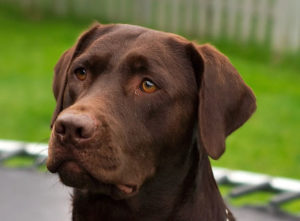
Most of us are familiar with the Labrador Retriever dog breed, such as the chocolate lab seen in Figure 15.5.1. But have you ever thought about what makes this dog brown? The difference between brown and black coat color in dogs is caused by a mutation in the TYRP1 gene. The TYRP1 gene provides instructions for making an enzyme called tyrosinase-related protein 1. This enzyme is required to produce a pigment called eumelanin. Eumelanin is a dark colored pigment. The TYRP1 gene is located on chromosome 11 in dogs (Parker, 2001).
A group of scientists who were interested in determining what caused the difference between black and brown coats sequenced the DNA within the protein-coding region of the TYRP1 gene (Schmutz, 2002). They identified three variations in the DNA making up the TYRP1 gene between brown dogs and black dogs. These variations in DNA sequence are examples of different alleles of the TYRP1 gene.
| Location | Black DNA Sequence | Brown DNA Sequence | Effect on Protein |
|---|---|---|---|
| exon 2 | TGT | CGT | changes a cysteine amino acid to a serine |
| exon 5 | CAG | TAG | introduces a premature stop codon which results in 330 amino acids instead of 512 amino acids in the protein |
| exon 5 | CCT | — (deleted) | deletion of a proline amino acid |
All of these variations in the DNA sequence are predicted to cause a change in the amino acid sequence of the TYRP1 protein. These changes affect the production of eumelanin pigment, which is black in color. When eumelanin is not being produced correctly, the dog appears brown instead of black.
Like other diploid organisms, dogs all have two copies of the TYRP1 gene (one from their male parent, one from their female parent). Dogs that are homozygous for the black allele (dogs that have two copies of the black allele) are obviously going to be black in color. Dogs that are homozygous for the brown allele are obviously going to be brown. Dogs that are heterozygous (dogs that have one black allele and one brown allele) appear black. The black and brown colors do not blend together: the black allele covers up the brown allele. This means that the black allele is dominant over the brown allele. Remember that dominant alleles cover up recessive alleles. If there is one dominant allele present, the dog will appear black. The brown allele is recessive to the black allele. There must be two copies of the recessive brown allele present in order for the dog to appear brown.
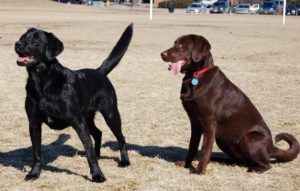
Remember that genotypes can be abbreviated with a single letter and that the letter which is chosen is typically the first letter of the dominant trait. In this case, the letter “B” is used to represent the dominant black allele, while “b” represents a recessive brown allele.
The reason that the black allele is dominant over the brown allele in this specific situation is because the black allele produces functional TYRP1 protein, while the brown allele does not. The presence of one functional allele produces enough TYRP1 protein and allows the cells to produce eumelanin and appear black.
Remember: Dominant does not mean “better” or “more normal” or “more frequent.” Black color does not confer any special advantages on dogs compared to brown color. It’s just a difference.
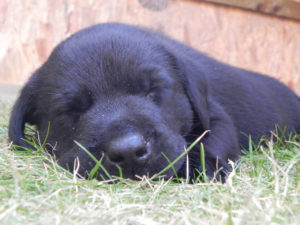
Let’s visualize the inheritance of black and brown using a pedigree. The pedigree in Figure 15.5.4 shows a litter of puppies. The shaded symbol shows a brown puppy, while open symbols are black individuals.
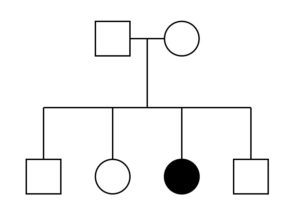
To interpret this pedigree, let’s start with information that we already know:
- Brown is recessive, which means brown individuals must have the genotype bb. In this pedigree, brown individuals are filled in.
- Black is dominant, which means black individuals must have at least one B allele. Their genotype could be either BB or Bb. In this pedigree, black individuals are not filled in.
Figure 15.5.5 shows the same pedigree, but with information about the individual’s genotypes filled in. We can also show the cross between these parents as a Punnett square. We would expect 1/4 of the offspring to have the genotype bb, and that is what we see in the pedigree above.
- The shaded individual, who is a brown female puppy, must have the genotype bb. If she had any B alleles, she would be black because the black allele is dominant over the brown allele.
- In order for the brown puppy to have the genotype bb, she must have gotten two “b” alleles: one from each of her parents. We know that her parents are both black (because they are unshaded), which means they must have a least one “B” allele. This means that both parents must be heterozygous: Bb.
- The three black puppies must have at least one “B” allele in order for them to be black in color. However, we can’t tell whether they are homozygous dominant (BB) or heterozygous (Bb) since both of those genotypes would result in black color. One way to represent this on a pedigree is B-, meaning that the second allele could be either B or b.
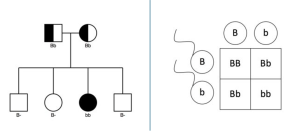
Recessive Alleles Lead to Yellow Color
Labrador Retrievers don’t only come in brown and black; they also come in yellow. Yellow color in labs is caused by variations in a different gene: MC1R. This gene controls the production of the melanocortin 1 receptor protein. MC1R is located on chromosome 5 in dogs (Schmutz, 2001).
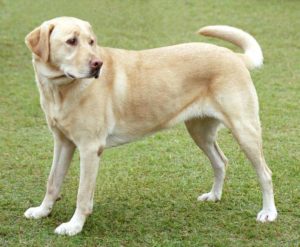
Melanocytes make two forms of melanin, eumelanin and pheomelanin. The relative amounts of these two pigments help determine the color of an individual’s hair and skin. Individuals who produce mostly eumelanin tend to have brown or black hair and dark skin that tans easily (in humans). Eumelanin also protects skin from damage caused by ultraviolet (UV) radiation in sunlight. Individuals who produce mostly pheomelanin tend to have red or blond hair, freckles, and light-colored skin that tans poorly. Because pheomelanin does not protect skin from UV radiation, people with more pheomelanin have an increased risk of skin damage caused by sun exposure.

The melanocortin 1 receptor (Mc1r) controls which type of melanin is produced by melanocytes. When the receptor is activated, it triggers a series of chemical reactions inside melanocytes that stimulate these cells to make eumelanin (brown). If the receptor is not activated or is blocked, melanocytes make pheomelanin (yellow). This means that if the receptor is working correctly and is turned on, dark pigment will be produced. If the receptor is not functional or is not turned on, light pigment will be produced.
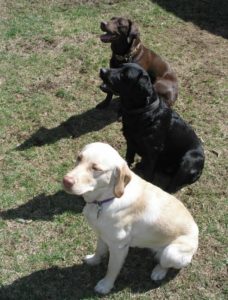
Schmutz et. al. (2002) determined the DNA sequence for the MC1R gene from dogs of various colors. They determined that black and brown dogs all have one allele of MC1R, while yellow and red dogs have a different allele. The allele that leads to yellow or red color has a premature stop codon which results in a shorter-than-normal protein. This protein would be predicted to not function correctly. Remember that when the melanocortin 1 receptor is not functioning correctly, light pheomelanin pigment is produced and not dark eumelanin.
Dogs that are homozygous for the functioning allele of MC1R (which would cause eumelanin to be produced) are dark in color. Dogs that are homozygous for the non-functioning allele (which would cause pheomelanin to be produced) are light in color. Dogs that are heterozygous are dark in color. What does this tell you about which allele is dominant? If you said “the dark allele is dominant because it covers up the light allele,” you’re correct. We will use “E” to represent the genotype at MC1R because the dominant phenotype in this case is the production of eumelanin. Dogs that have the genotype EE or Ee will produce eumelanin and be dark. Dogs that have the genotype “ee” will produce pheomelanin and be light.
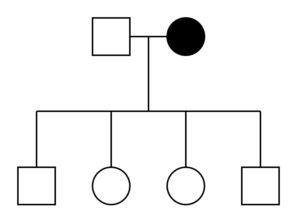
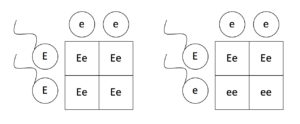
The cross shown in Figure 15.5.9 can also be shown as a Punnett square (Figure 15.5.10). Since we are unsure whether the male dog has the genotype “EE” or “Ee,” we have to make two Punnett squares. Since all of the puppies resulting from this cross were black, we would predict that the first Punnett square shows the cross. However, it is possible that the second Punnett square is correct. There are only 4 puppies, so it’s not hard to imagine that they could all be black even though the Punnett square predicts only 50% black. It would be comparable to flipping a coin 4 times and getting 4 heads in a row. Getting 4 heads in a row is less likely, but definitely possible.It is very important to note here that yellow dogs still have the TYRP1 gene, even though they are not black or brown!
Epistasis
Dogs don’t have either the TYRP1 gene or the MC1R gene—they have both. In fact, every dog will have two copies of the TYRP1 gene and two copies of the MC1R gene. Since both genes control aspects of coat color, it makes sense that they interact. In fact, TYRP1 and MC1R have what is called an epistatic relationship: the action of one gene controls the expression of a second gene. Another way to phrase this relationship is that the effect of one gene is dependent on another gene.
Remember that TYRP1 is required for the production of eumelanin. The dominant allele of TYRP1 (B) produces black eumelanin, while the recessive allele (b) produces brown eumelanin. However, if a dog is homozygous recessive for MC1R (ee), they lack the ability to produce eumelanin at all. If no eumelanin is being produced, it doesn’t matter whether it would have been black or brown: there is none. This means that any dog that is homozygous recessive for MC1R will appear yellow regardless of its genotype at TYRP1. These two genes are epistatic: the action of MC1R controls the expression of TYRP1. The effect of TYRP1 is dependent on MC1R.
If a dog has at least one dominant functioning allele of MC1R, then its genotype at TYRP1 can be seen. If the dog has at least one dominant allele of TYRP1, it will appear black. If it has two recessive alleles, it will appear brown. A pedigree can be used to show the inheritance of two different genes such as TYRP1 and MC1R (Figure 15.5.12). Punnett squares can also be used to show this cross. If the probability of inheriting one trait is multiplied by the probability of inheriting the second trait, the overall probability of getting any given offspring can be determined (Figure 15.5.13).
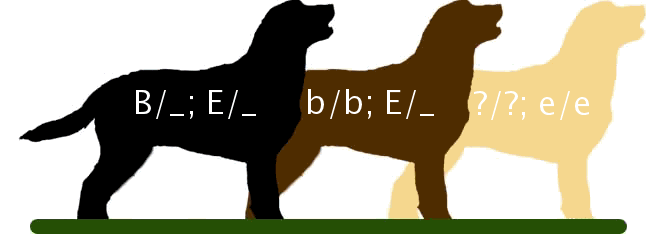
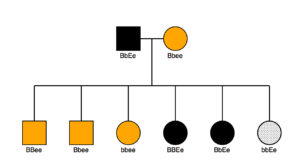
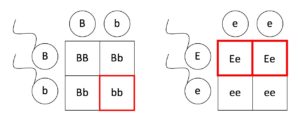
Incomplete Dominance
Mendel’s results in crossing peas, black vs brown fur color, and eumelanin production vs pheomelanin production all demonstrate traits are inherited as dominant and recessive. However, sometimes heterozygote phenotype is intermediate between the two parents. For example, in the snapdragon, Antirrhinum majus (Figure 15.5.14), a cross between a homozygous parent with white flowers (CWCW) and a homozygous parent with red flowers (CRCR) will produce offspring with pink flowers (CRCW) (Figure 15.5.15).

Note that different genotypic abbreviations are used to distinguish these patterns from simple dominance and recessiveness. The abbreviation CW can be read as “at the flower color gene (C), the white allele is present.”
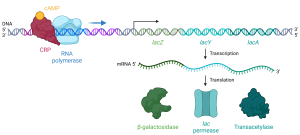
This pattern of inheritance is described as incomplete dominance, meaning that neither of the alleles is completely dominant over the other: both alleles can be seen at the same time. The allele for red flowers is incompletely dominant over the allele for white flowers. Red + white = pink. The results of a cross where the alleles are incompletely dominant can still be predicted, just as with complete dominant and recessive crosses. Figure 15.5.16 shows the results from a cross between two heterozygous individuals: CRCW x CRCW . The expected offspring would have the genotypic ratio 1 CRCR:2 CRCW:1 CWCW, and the phenotypic ratio would be 1:2:1 for red:pink:white. The basis for the intermediate color in the heterozygote is simply that the pigment produced by the red allele (anthocyanin) is diluted in the heterozygote and therefore appears pink because of the white background of the flower petals.
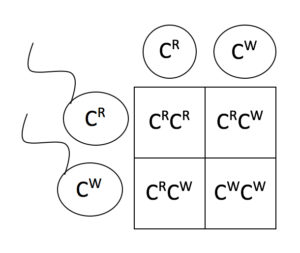
Straight, Curly, and Wavy Hair in Dogs
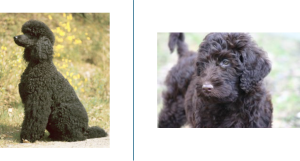
Another example of incomplete dominance is the inheritance of straight, wavy, and curly hair in dogs. The KRT71 gene is used to synthesize the keratin 71 protein. Genes in the KRT family provide instructions for making proteins called keratins. Keratins are a group of tough, fibrous proteins that form the structural framework of epithelial cells, which are cells that line the surfaces and cavities of the body. Epithelial cells make up tissues such as the hair, skin, and nails. These cells also line the internal organs and are an important part of many glands. Keratins are also involved in several other critical cell functions, including cell movement (migration), regulation of cell size, cell growth and division (proliferation), wound healing, and transport of materials within cells. Different combinations of keratin proteins are found in different tissues.
The mutation which causes curly hair in dogs, such as the labradoodle seen in Figure 15.5.17, is in exon 2 of the gene and is predicted to substantially disrupt the structure of the keratin 71 protein (Cadieu, 2009). This change in protein shape prevents the keratin proteins from interacting together correctly within the hair, altering the structure of the hair and resulting in a curly coat (Runkel, 2006). When a dog has two curly alleles (KCKC), it has a very curly coat, such as on the pure-bred poodle in Figure 15.5.17. A dog with two straight alleles (K+K+) has a straight coat. Dogs that are heterozygous (K+KC) have an intermediate or wavy coat like the labradoodle in Figure 15.5.17.
Co-Dominance
In humans, blood is classified into different groups according to the presence or absence of molecules called antigens on the surface of every red blood cell in a person’s body. Antigens determine blood type and can either be proteins or complexes of sugar molecules (polysaccharides). The genes in the blood group antigen family provide instructions for making antigen proteins. Blood group antigen proteins serve a variety of functions within the cell membrane of red blood cells. These protein functions include transporting other proteins and molecules into and out of the cell, maintaining cell structure, attaching to other cells and molecules, and participating in chemical reactions.
There are 29 recognized blood groups, most involving only one gene. Variations (polymorphisms) within the genes that determine blood group give rise to the different antigens for a particular blood group protein. For example, changes in a few DNA building blocks (nucleotides) in the ABO gene give rise to the A, B, and O blood types of the ABO blood group. The changes that occur in the genes that determine blood group typically affect only blood type and are not associated with adverse health conditions, although exceptions do occur.
The A and B alleles are co-dominant. If both the A and B alleles are present, both will be seen in the phenotype. The O allele is recessive to both A and B.
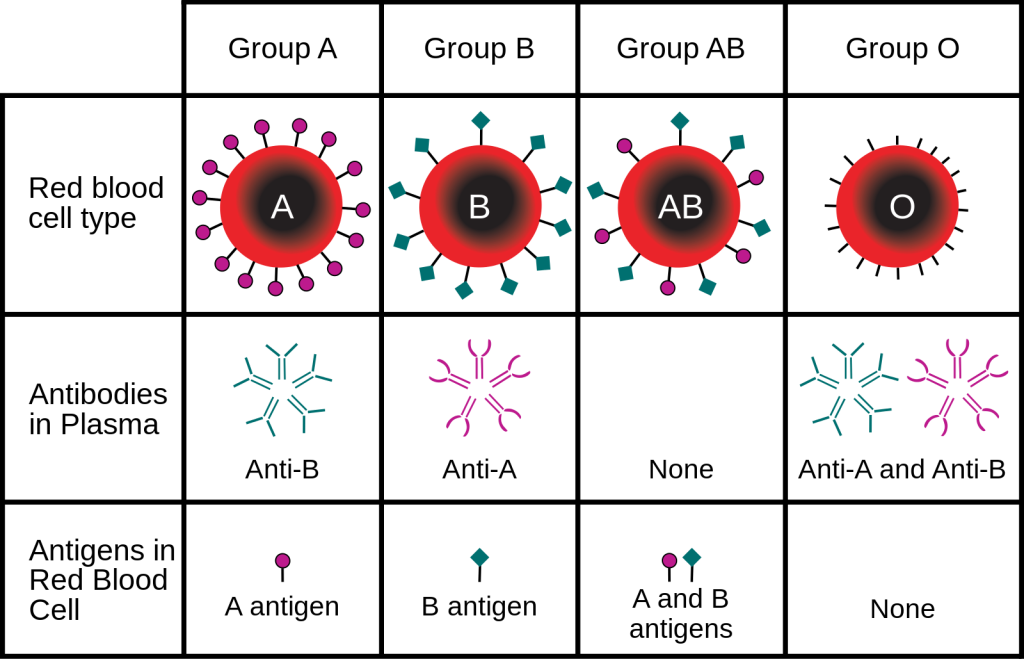
Practice Questions
Section Summary
The color of Labrador Retrievers’ coats (black, yellow, and chocolate) is determined by the interaction of two genes: TYRP1 and MC1R. Black Labs have at least one dominant allele of TYRP1 (B), which produces black eumelanin, and one dominant allele of MC1R (E), which allows eumelanin production. Yellow Labs occur when dogs are homozygous recessive for MC1R (ee), preventing eumelanin production, regardless of the TYRP1 genotype. Chocolate Labs are caused by two recessive alleles of TYRP1 (bb), producing brown eumelanin, but still require at least one dominant allele of MC1R (E) for eumelanin production. The inheritance of these traits follows patterns of dominance and epistasis, with the TYRP1 gene controlling the brown/black pigment and the MC1R gene influencing whether eumelanin is produced at all. Complete dominance is observed for black and brown fur, where the black allele (B) is dominant over brown (b). Epistasis occurs when the MC1R gene overrides the effects of TYRP1, making MC1R crucial for determining whether eumelanin (black or brown) can be produced. Incomplete dominance is also seen in traits like hair texture, where straight, wavy, and curly hair in dogs (e.g., Labradoodles) result from mutations in the KRT71 gene, with heterozygotes showing an intermediate wavy coat. Punnett squares and pedigrees are useful tools for predicting the inheritance of these traits.
Glossary
- complete dominance
- A genetic pattern where one allele completely masks another in heterozygotes (e.g., Bb results in black fur, not a blend)
- dominant allele
- An allele that shows its effect even if only one copy is present. Represented with a capital letter (e.g., B, E)
- epistasis
- A genetic interaction where one gene masks or overrides the effect of another gene (e.g., MC1R controls TYRP1 expression)
- eumelanin
- A dark pigment that gives dogs black or brown fur; requires a functional MC1R gene to be produced
- heterozygous
- Having two different alleles for a gene (e.g., Bb, Ee)
- homozygous
- Having two identical alleles for a gene (e.g., BB, bb, EE, or ee)
- incomplete dominance
- A pattern where the heterozygous phenotype is intermediate between two homozygous phenotypes (e.g., red + white flowers = pink flowers)
- MC1R gene
- A gene that controls whether eumelanin or pheomelanin is produced; the E allele allows eumelanin; the e allele blocks it, resulting in yellow
- pedigree
- A family tree diagram showing inheritance of traits across generations
- pheomelanin
- A light pigment responsible for yellow or red fur color in dogs, produced when MC1R is non-functional (ee genotype)
- Punnett square
- A diagram used to predict the genotypes and phenotypes of offspring from a genetic cross
- recessive allele
- An allele that only shows its effect when two copies are present; represented with a lowercase letter (e.g., b, e)
- TYRP1 gene
- A gene involved in eumelanin pigment production; the dominant B allele produces black pigment; the recessive b produces brown
References
Cadieu, E., Neff, M. W., Quignon, P., Walsh, K., Chase, K., Parker, H. G., Vonholdt, B. M., Rhue, A., Boyko, A., Byers, A., Wong, A., Mosher, D. S., Elkahloun, A. G., Spady, T. C., André, C., Lark, K. G., Cargill, M., Bustamante, C. D., Wayne, R. K., & Ostrander, E. A. (2009). Coat variation in the domestic dog is governed by variants in three genes. Science, 326(5949):150–3.
Runkel, F., Klaften, M., Koch, K., Böhnert, V., Büssow, H., Fuchs, H., Franz, T., & Hrabé de Angelis, M. (2006). Morphologic and molecular characterization of two novel Krt71 (Krt2-6g) mutations: Krt71rco12 and Krt71rco13. Mammalian Genome, 17(12):1172–82.
“Keratins” by Genetics Home Reference: Your Guide to Understanding Genetic Conditions, National Institutes of Health: U.S. National Library of Medicine is in the Public Domain.
Schmutz, S. M., Berryere, T. G., & Goldfinch, A. D. (2002). TYRP1 and MC1R genotypes and their effects on coat color in dogs. Mammalian Genome, 13:380–387.
Parker, H. G., Yuhua, X., Mellersh, C. S., Khan, S., Shibuya, H., Johnson, G. S., & Ostrander, E. A. (September 2001). Meiotic linkage mapping of 52 genes onto the canine map does not identify significant levels of microrearrangement. Mammalian Genome, 12(9):713–8.
Schmutz, S. M., Berryere, T. G., & Goldfinch, A. D. (2002). TYRP1 and MC1R genotypes and their effects on coat color in dogs. Mammalian Genome, 13:380–387.
Information about TYRP1 and oculocutaneous albinism type 3: “Tyrp1” by Genetics Home Reference: Your Guide to Understanding Genetic Conditions, National Institutes of Health: U.S. National Library of Medicine is in the Public Domain.
Schmutz, S. M., Moker, J. S., Berryere, T. G., Christison, K. M., & Dolf, G. (2001). An SNP is used to map MC1R to dog chromosome 5. Animal Genetics, 32(1):43–4.
Schmutz, S. M., Berryere, T. G., & Goldfinch, A. D. (2002). TYRP1 and MC1R genotypes and their effects on coat color in dogs. Mammalian Genome, 13:380–387.
Figure Descriptions
Figure 15.5.4. A pedigree diagram shows a male (square) and female (circle) at the top, both unshaded to indicate they are not brown. A horizontal line connects them, with a vertical line leading to four offspring: an unshaded male (square), an unshaded female (circle), a shaded female (circle, indicating a brown phenotype), and an unshaded male (square). The filled symbol denotes the individual with the brown trait. [Return to Figure 15.5.4]
Figure 15.5.5. The left diagram is a pedigree chart. The father (square) is half black and half white and labeled Bb, and the mother (circle) is also half black and half white and labeled Bb. They have four children: an unshaded male labeled B-, an unshaded female labeled B-, a shaded female labeled bb, and an unshaded male labeled B-. The right diagram is a Punnett square showing the cross between two heterozygous individuals (B and b across the top and side). The grid shows the results: BB in the top-left cell, Bb in the top-right, Bb in the bottom-left, and bb in the bottom-right. [Return to Figure 15.5.5]
Figure 15.5.7. The left panel illustrates a cross-section of a hair follicle embedded in skin, with a pigmented hair shaft emerging upward. Inside the follicle, small round melanocyte cells, labeled “Melanocytes: Cells that produce melanin,” are shown at the hair’s base. The right panel shows a schematic of the Mc1r receptor as a coiled red membrane-bound protein. Above it, a plus sign labeled “Activator” increases signaling, leading to an “Active receptor (high signaling)” that produces dark brown pigment. Below it, a minus sign labeled “Antagonist” decreases signaling, leading to a “Repressed receptor (low signaling)” that produces yellow pigment. [Return to Figure 15.5.7]
Figure 15.5.9. A simple pedigree chart shows a mating pair: an unshaded square (male) connected to a filled black circle (female). The filled circle represents a yellow-coated individual with genotype ee, producing pheomelanin. Below them, four offspring symbols (two circles for females and two squares for males) are all unshaded, indicating dark-colored coats. The accompanying information states that since all offspring are dark, the male’s genotype is predicted to be EE, resulting in 100% Ee offspring that produce eumelanin. [Return to Figure 15.5.9]
Figure 15.5.10. The image shows two side-by-side Punnett squares representing genetic crosses. Left square: One parent is EE and the other is ee. All four boxes show the genotype Ee, indicating 100% of offspring will be heterozygous and produce eumelanin (dark pigment). Right square: One parent is Ee and the other is ee. Two boxes show Ee and two show ee, indicating a 50% chance of offspring producing eumelanin and a 50% chance producing pheomelanin (yellow pigment). [Return to Figure 15.5.10]
Figure 15.5.11. The image shows three silhouettes of Labrador Retrievers in black, chocolate, and yellow, each labeled with genotype combinations for TYRP1 (B) and MC1R (E) that determine coat color. The black Labrador is labeled “B/; E/,” indicating at least one dominant B allele at TYRP1 and one dominant E allele at MC1R, producing black fur (eumelanin). The chocolate Labrador is labeled “b/b; E/_,” indicating two recessive b alleles at TYRP1 and at least one dominant E allele at MC1R, producing brown fur (eumelanin). The yellow Labrador is labeled “?/?; e/e,” indicating two recessive e alleles at MC1R, producing yellow fur (pheomelanin) regardless of TYRP1 genotype. [Return to Figure 15.5.11]
Figure 15.5.12. A pedigree chart shows a cross between a black Labrador with genotype BBEe (black square) and a yellow Labrador with genotype Bbee (yellow circle). Their six offspring are depicted from left to right: a yellow square labeled BBee, a yellow square labeled Bbee, a yellow circle labeled bbee, a black circle labeled BBEe, a black circle labeled BbEe, and a grey circle labeled bbEe representing a brown Labrador. The pedigree uses black shading for black coats, yellow shading for yellow coats, and grey shading for brown coats. [Return to Figure 15.5.12]
Figure 15.5.13. The left Punnett square shows a cross between B and b alleles, producing genotypes BB, Bb, Bb, and bb. The bb cell is outlined in red. The right Punnett square shows a cross between E and e alleles, producing genotypes Ee, Ee, ee, and ee. Both Ee cells are outlined in red. These diagrams are used to calculate the probability of producing a brown dog from a Bbee × BbEe cross. [Return to Figure 15.5.13]
Figure 15.5.15. A Punnett square with one parent labeled CW in both gametes and the other labeled CR in both gametes. All four squares in the grid show CRCW, representing 100% pink offspring. [Return to Figure 15.5.15]
Figure 15.5.16. A Punnett square with both parents producing CR and CW gametes. The four offspring combinations are CRCR, CRCW, CRCW, and CWCW, representing red, pink, pink, and white flowers respectively. [Return to Figure 15.5.16]
Figure 15.5.18. The diagram shows four red blood cells labeled A, B, AB, and O, each with distinct antigen markers on their surfaces. Type A cells have pink circular antigens (A antigens) and anti-B antibodies shown as teal Y-shaped structures. Type B cells have teal square antigens (B antigens) and anti-A antibodies shown as pink Y-shaped structures. Type AB cells display both A and B antigens and no antibodies. Type O cells have no antigens on their surface and both anti-A and anti-B antibodies. Pink circles in the legend represent A antigens, teal squares represent B antigens, teal Y-shapes represent anti-B antibodies, and pink Y-shapes represent anti-A antibodies. [Return to Figure 15.5.18]
Licenses and Attributions
This chapter, “Allelic Relationships: Traits, Dominance, and Epistasis,” by Elizabeth Dahlhoff, is adapted from chapters in Genetics: Dog Coat Color from in Principles of Biology by Lisa Bartree, Walter Shriner and Catherine Creech (Mt. Hood Community College) under a CC BY-NC 4.0 license. This work is licensed under a CC BY-NC 4.0 license.
Media Attributions
- pedigree2b and bpedigree
- Screenshot 2025-07-18 at 1.57.36 PM
- LabRetColors
- 10l.snapdragon
- 1C-J-1.4 Figure – lac operon without glucose © Michelle McCully is licensed under a CC BY-NC (Attribution NonCommercial) license
- Pudel_Grossschwarz and labradoodle
- ABO_blood_type
